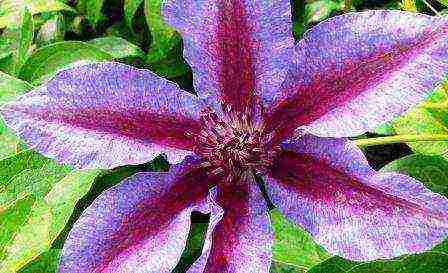Content
Flowers in the life of a summer resident or gardener occupy their own, separate, niche. Many people prefer the rose. She is considered the queen of flowers and is appreciated for its unique look, shape and aroma. Thanks to the desire of gardeners for new achievements in the field of flower breeding, completely new species of this wonderful plant are created, which are unique, graceful and incredibly beautiful. These are the characteristics that the roses of David Austin are endowed with. They concentrate the best qualities taken from long-existing varieties. They have their own flavor, and almost everyone likes them.
Roses by David Austin - a long way to the success of what you love
The history of the emergence of this type of roses is very interesting. It should be noted that a person gave all his strength and knowledge for the benefit of the appearance of unique flowers. The beginning of the difficult path of breeding the first Ostins was laid in England in the 50s of the twentieth century.
When a young amateur florist named David Austin returned from a trip to Europe, he wanted to create original varieties of roses, which in the future will be positioned as David Austin's English roses. The encyclopedia of roses will be replenished with new varieties, and they will enjoy great success.
He was literally captivated by the beauty of these flowers, but the fact that most of the varieties he saw bloomed only once a season and not for long, he was a little upset. Then David decided to combine all the advantageous qualities and discard the disadvantages. And he devoted his whole life to this.
In practical research, Austin used existing varieties that were not very popular. The basis was tea-hybrid, floribunda, Damascus and French. As a result of crossing hybrid tea, large-flowered re-flowering varieties, and old, sophisticated, resistant and not whimsical once-flowering varieties, David Austin managed to breed the original rose, which was named Constance Spry. It was she who became the beginning of the long path of the English breeder.
Constance Spry was about half a century old, but to this day it is quite popular. She became the basis for future new varieties of roses by David Austin (see photo). First introduced to the Constance Spry by a friend of the English breeder, Graham Thomas in 1961. It can be classified as climbing roses, although a beautiful bush can be formed if the shoots are carefully trimmed. In this case, you will get an excellent garden bush, up to 2 m high. A characteristic feature of most varieties of D. Austin's roses are fragrant, large flowers. And in Constance Spry their diameter can reach 15 cm. The buds are collected in neat brushes. Their shape is cupped. The flowers themselves, as if not fully opened. They bloom on stems, the length of which can reach 6 m. The foliage of these flowers is light green with a matte shade. Shoots have thorny thorns. It blooms only once in July. This quality did not suit the grower. In addition, the variety required careful protection from diseases and pests.
The work continued. He was looking for new approaches. Only after the third backcrossing of the main variety with the hybrid, almost all varieties (seedlings) of Austin roses inherited the duration of flowering.
Also, the English breeder was worried about the problem of the endurance of new plants.During the 60s, it was not possible to create decent resistant varieties. In the early 70s, David was able to breed disease resistant roses. The very first variety endowed with such qualities is The Mayflower. This is a versatile Austin rose variety that many gardeners have been looking for. During the years of cultivation, no signs of any disease were noticed on the foliage of this plant. In this regard, The Mayflower was awarded a royal award, namely, received a quality seal from the British Royal Horticultural Society.
In addition to The Mayflower, other varieties of Austin's English roses received the same award:
In 1969, David Austin Roses was established. This event was marked by the receipt of a whole series of scrub hybrid roses, the flowers of which had double petals. Wife of Bath was recognized as the best plant in the Austin Rose Nursery of this series.
While the newly-minted company was gaining momentum, work on improving the quality characteristics did not stop for an hour. The year 1983 was truly life-changing. In the suburb of London, which is called Chelsea, a flower exhibition was held, which presented the best varieties of Austin roses - Mary Rose and Graham Thomas. They have gained great popularity not only in England but throughout the world. Since then, Austin's roses (see photo) have become world famous, unique and recognizable.
In the 21st century, the management of the company was transferred to the son of a famous English breeder. The territory of the nurseries is in the open air. This is a real flower-growing museum, where you forget about everything in the world, and just admire the incredible beauty and abundance of varieties of roses (more than 200 varieties are concentrated).
Today it is not difficult to buy seedlings of Austin English roses and seed material. There are many shops on the Internet that provide an opportunity for interested flower growers to grow beautiful varieties. Each year, David Austin Rose Nurseries produce about 4-6 new varieties of these flowers. Branches of the company are located in all parts of the world. They have about 4.5 million seedlings.
Officially, English roses are not bred into a separate group, but behind the scenes, Ostinki are considered the hallmark of British floriculture. Most of D. Austin's varieties are bush roses (shrubs). The selection of the company "David Austin Roses" includes several climbing:
They are used to create a unique landscape design for a summer cottage or private houses.
Great attention should be paid to two unique varieties of David Austin roses (the catalog displays them as "the best of the best"). The peculiarity is that they bloom very slowly and in a semi-release resemble hybrid tea roses. A characteristic feature is the rigidity of the petals and the severity of the forms. Inflorescences are large-flowered. They are resistant to adverse weather conditions and many diseases.
The best roses of David Austin:
Austin's peony roses also stand out:
Red varieties:
David Austin Cream Peony Roses:
What is the difference? Firstly, the bushes reach over one and a half meters in height. Secondly, on one brush, there are up to 8 large (up to 14 cm in diameter) flowers. They are very fragrant and uniquely beautiful.
The best varieties of roses selected by David Austin for container or flowerpot growing at home:
There is also one of the best breeding developments in the company's catalog, which is endowed with resistance to extreme cold. This is an Austin rose (winter hardy variety) called Snow Goose. It is characterized by small white flowers, collected in large clusters. The petals are of different lengths and grow, as it were, in layers. This plant should be classified as climbing, abundantly flowering varieties. Although summer residents note that if you wish, you can form a good bush.
In addition to Snow Goose, there are other Austin most winter-hardy roses:
New items from David Austin kennel
Constant novelties, which are displayed in nurseries of Austin English roses, immediately become popular among fans of the famous breeder's rose garden.
The freshest (new) varieties of David Austin:
- Dezdemona... Refers to park views.A characteristic feature is a rich pink-peach shade and rounded bushes, up to 1.2 m high. Very fragrant, its heady scent spreads throughout the garden. The flowers are large, at first they have a white tint, but over time they acquire a peach tone. The foliage is glossy green, saturated. This plant has excellent flowering continuity. Almost without interruption, it pleases with its unique flowers. They make bouquets of roses well. David Austin can only be thanked for such a wonderful plant.
- The Albrighton Rambler (The Albrighton Rambler). Belongs to Austin climbing varieties. The incredible beauty of this plant is simply mesmerizing. This Austin rose (see photo) has a light nutmeg aroma and it blooms for a long period, up to frost. It is resistant to many diseases.
- Olivia Rose Austin (Olivia Rose Austin). The names of Austin roses are always confined to something or dedicated to some personality that takes place in the life of the breeder. Olivia Rose Austin is no exception. It was named after the granddaughter (daughter of the eldest son). The flowers grow large and beautiful, the bushes are of the correct shape. The scent spreads throughout the garden with fruity notes. It should be noted that the plant blooms very early and blooms continuously. Olivia Rose Austin is resistant to many diseases. Some summer residents note that it is also Austin's winter-hardy rose.
- The Poet's Wife Translated from English means the Poet's Wife. Very beautiful new product of 2016. This Austin double rose (see photo with the name) has a yellowish tint and a complex rosette of flowers. It blooms for a long time, without interruption. Shoots form large, dense, rounded bushes, about a meter high. The aroma is very intense. It has notes of lemon and peach. In continuous flowering beds, can be planted in the foreground. The Poet's Wife rose has a really alluring look and a magnificent aroma that inspires creativity.
- The Ancient Mariner One of the latest novelties, which was released in 2017. The peculiarity of flowering is remarkable. Densely double, large flowers bloom slowly, revealing the incredible beauty of the inside. This is a two-color Austin rose, at first it has delicate lilac petals, and then the inner leaves of saturated shades appear. The bush can reach a height of one and a half meters. The Ancient Mariner is a continuous flowering cultivar. It is used for growing in parks and summer cottages.
David Austin's company never stops developing new, unique varieties. The ship, called David Austin Roses, continues its voyage, and its flowers are rapidly gaining popularity.
The best varieties of roses D. Austin, video
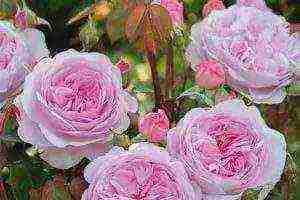
David Austin's English roses (a photo-catalog of varieties will be presented below) are a fairly new type of roses, which, according to the modern classification, belongs to scrubs - large, abundantly flowering shrubs (they are also called park roses).
Against the background of the love of rose growers for old roses that broke out fifty years ago, these magnificent flowers appeared.
History of creation
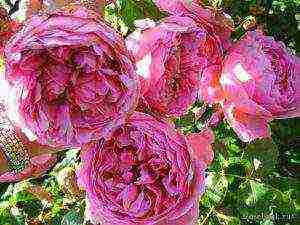 Since the middle of the nineteenth century, the main efforts of breeders have been aimed at creating modern varieties of hybrid tea roses with many colors and repetitive flowering. Parks and ancient cultures were almost forgotten.
Since the middle of the nineteenth century, the main efforts of breeders have been aimed at creating modern varieties of hybrid tea roses with many colors and repetitive flowering. Parks and ancient cultures were almost forgotten.
In the early fifties of the twentieth century, David Austin, an English breeder, during his trip to France saw old garden roses and fired up the dream of creating a flower of the same shape, but with repeated flowering.
The breeder has crossed the old Belle Isis with the modern Dainty Maid. This is how the first "Austin" - Constance Spry was obtained. The only drawback of this beauty was the one-time flowering during the early summer.
In addition, David wanted to diversify the color of his roses. Graham Thomas was bred in 1983 and stood out from the rest with its rich yellow buds. Today, Graham Thomas is represented in the World Rose Hall of Fame.
Today, 12 of David Austin's finest rose varieties have been awarded the British Royal Horticultural Society's seal of excellence.David Austin managed to select about two hundred varieties of roses and new items constantly appear in the catalog. About four million shrubs are sold annually. Now there is a discussion on the possibility of separating them into a separate group.
Advantages and disadvantages
 The main advantages of English roses are:
The main advantages of English roses are:
- the presence of a strong aroma;
- high winter hardiness of the plant in Russian conditions;
- the formation of flowers throughout the stem;
- an unusual flower shape that differs from other types of roses.
But these roses also have disadvantages:
- poor resistance to atmospheric precipitation;
- under the weight of flowers, young shoots often droop;
- many dark colored plants are prone to black spotting.
Landing
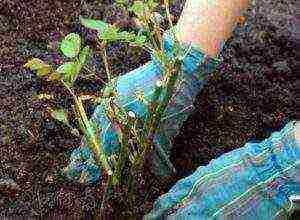 When choosing a landing site, you must consider:
When choosing a landing site, you must consider:
- roses grow well in partial shade;
- British roses are mostly tall;
It is important: when planting seedlings, you need to pay attention to its depth. The inoculation site should be 10 cm deep.
- good for creating hedges from live plants;
- best grown in groups.
Care
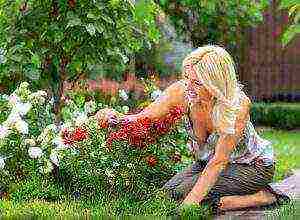 The features of care are as follows:
The features of care are as follows:
- flowers of certain varieties are weakly resistant to precipitation and their buds must be constantly shaken off from rain drops;
- English roses are spray roses, so they need pruning;
- the shoots of the flower are drooping, and therefore it is recommended to use additional supports when growing roses.
Application in landscape design
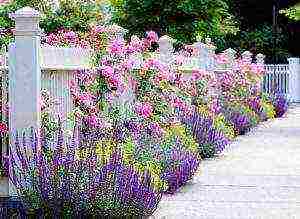 English roses are of the shrub type. The branches droop beautifully to the ground.
English roses are of the shrub type. The branches droop beautifully to the ground.
All varieties are profusely flowering, so it is good to use them in landscape design when creating mixborders and flower beds.
At the bottom of the bush it is good to "settle" undersized heucheras and hosts.
There are many videos and pictures on the Internet where you can clearly see how famous designers use these beautiful roses in their designs.
Varieties catalog
Golden Celebration
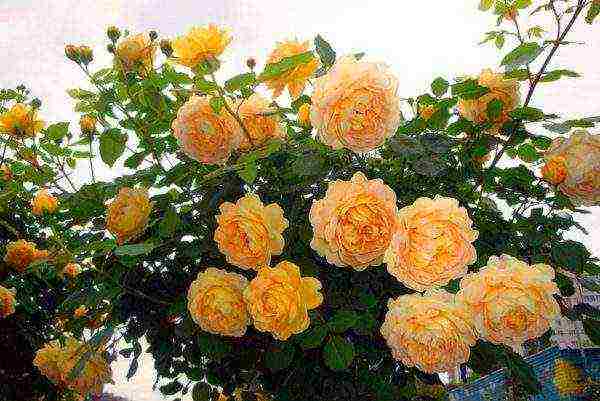
Golden Celebration grade
- gorgeous large yellow flowers with a copper tint and a pleasant aroma. The bush is medium-sized, spreading, fast-growing (reaches a height of 150 centimeters);
- high "resistance" to diseases;
- resistance to precipitation is weak;
- blooms again.
Charlotte
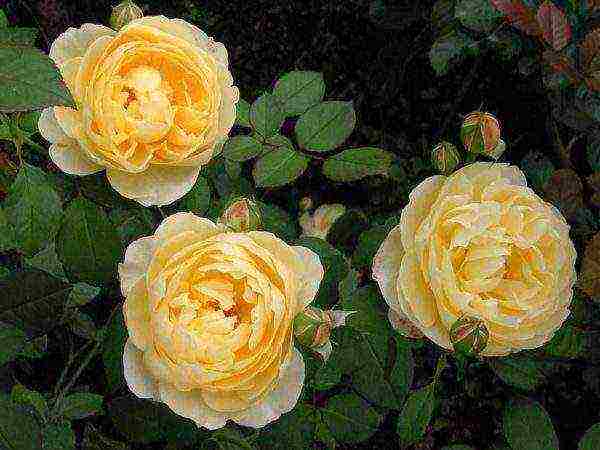
Charlotte variety
- vigorous culture with double lemon-yellow flowers. The outer petals are slightly lighter. Weak aroma;
- moderate disease resistance;
- satisfactory resistance to rain and snow;
- re-flowering variety;
- features: it is better to plant the plant in the shade, as the petals can fade in the sun.
Scepter'd Isle
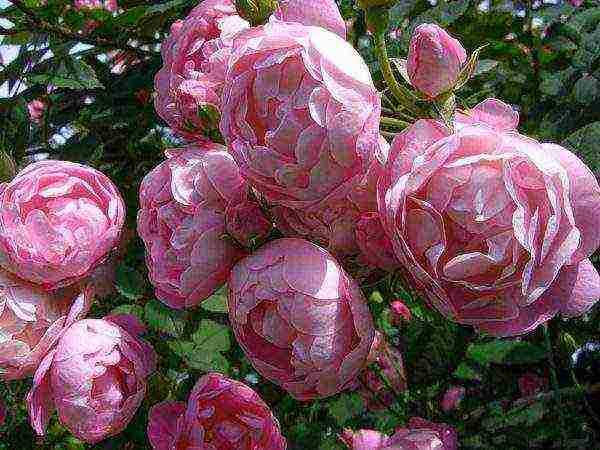
Septa d'yle variety
- medium-sized plant with pink buds. The outer petals are almost white. Pleasant aroma of myrrh;
- disease resistance: high;
- flowering: continuous;
- in hot climates it reaches a height of 2 meters.
L.D. Braithwaite

Variety Al Dee Braithwaite
- densely double flowers, changing the color range of buds from bright red to cherry pink. The bush is low, wide;
- low disease resistance;
- especially resistant to precipitation grade;
- flowering is continuous;
- features: the culture tolerates partial shade well.
Eglantyne
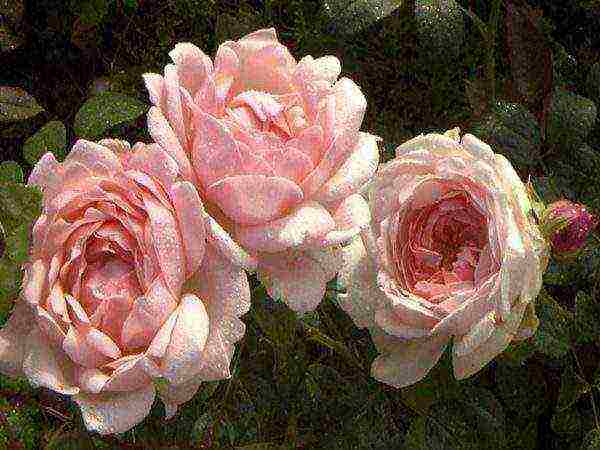
Eglantine variety
- one of the best varieties of David Austin. Delicate pink buds gradually fade to an almost white color. The bush is very thorny, vigorous, branched;
- disease resistance: medium. A special danger is black spot;
- not resistant to precipitation;
- continuous flowering.
Mary Rose
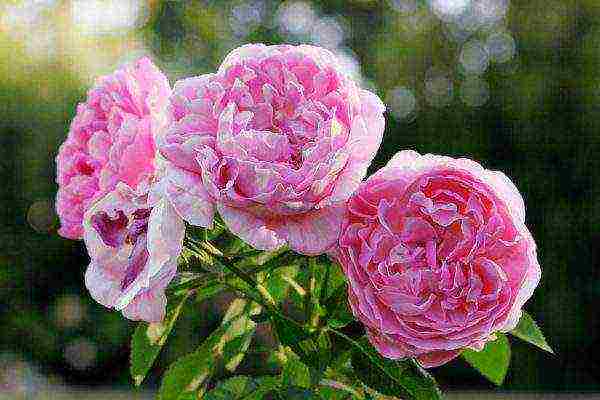
Mary Rose variety
- Description: flowers are bright, pleasant pink color with wavy petals. Strongly branched bush, about a meter high. The variety is very popular among flower growers;
- disease resistance: medium. More often than others, it is prone to black spot;
- medium resistance to precipitation;
- flowering abundant, repeated.
Evelyn
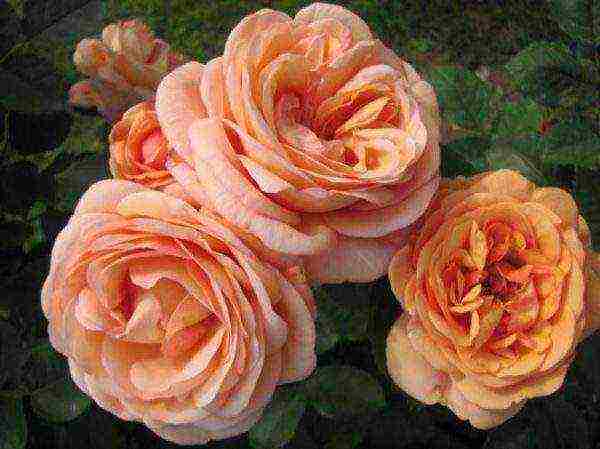
Evelyn variety
- flowers are apricot-yellow in color with a slight pink tint. Stems are erect, but sometimes droop. Persistent pleasant aroma;
- disease resistance: medium;
- low degree of resistance to precipitation;
- blooms profusely at the very beginning of summer.
Claire Austin
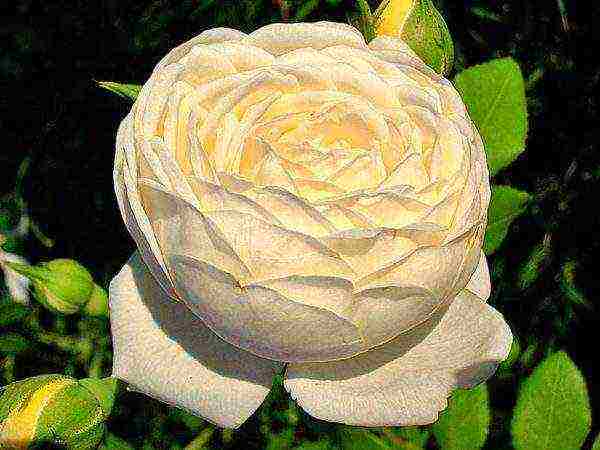
grade Claire Austin
- Description: Flowers of delicate lemon-white color, very aromatic. Stems with drooping shoots, strongly leafy;
- disease resistance is average;
- low resistance to precipitation;
- re-flowering variety.
Graham Thomas

Graham Thomas variety
- according to gardeners' reviews, the most popular English rose among the yellow varieties. The bush is medium-sized, the foliage is glossy, shiny;
- average disease resistance;
- good resistance to precipitation;
- flowering: repeated.
Gertrude Jekyll
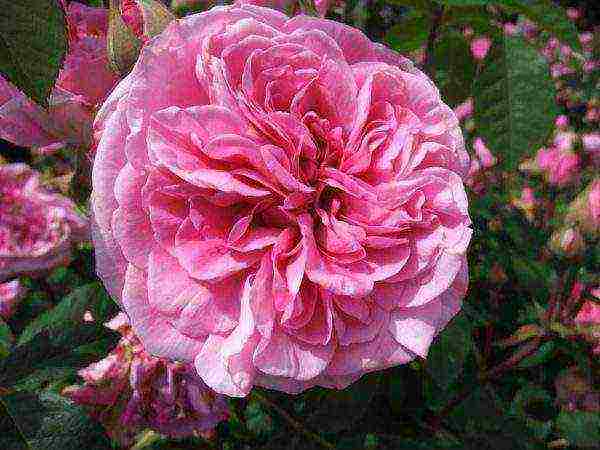
Gertrude Jekyll variety
- Description: very fragrant, large, deep pink flowers;
- erect bush, prickly and tough shoots;
- disease resistance: medium;
- resistance to temperature extremes is weak;
- re-flowering. Requires mid-summer pruning.
Pat Austin
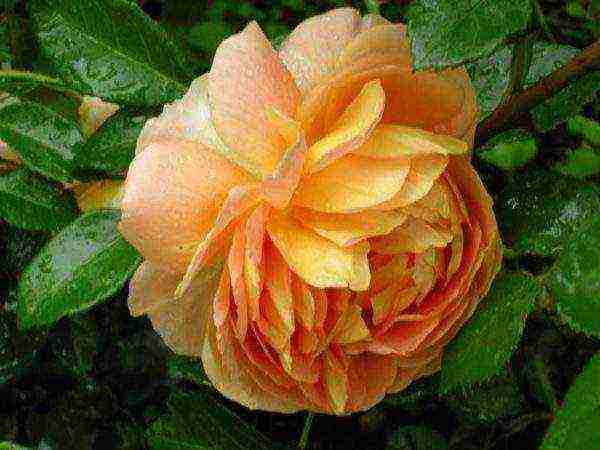
Variety Pat Austin
- Description: large orange flowers. In hot summer, the petals at the edges can fade to yellow. The bush is low, the foliage is dark;
- poor adaptability to sudden temperature changes and diseases;
- blooms again;
- features: under the weight of the buds, the shoots bend to the ground.
Molineux
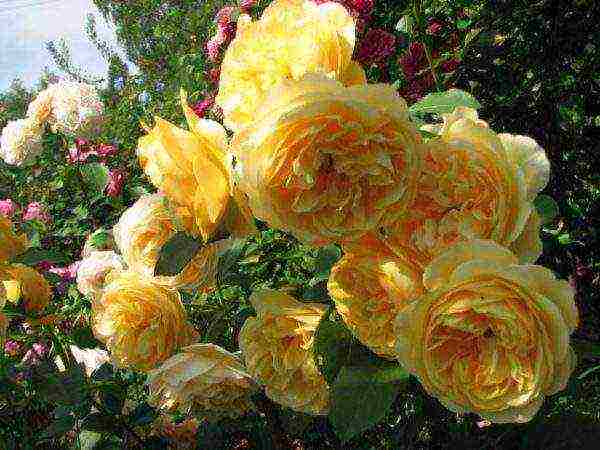
Molyneux variety
- Description: large yellow flowers with a pinkish core. The bush is low, compact, few thorns;
- average disease resistance;
- resistance to precipitation is high;
- the variety thrives in both hot and cold climates. Repeated blooming.
Abraham Darby
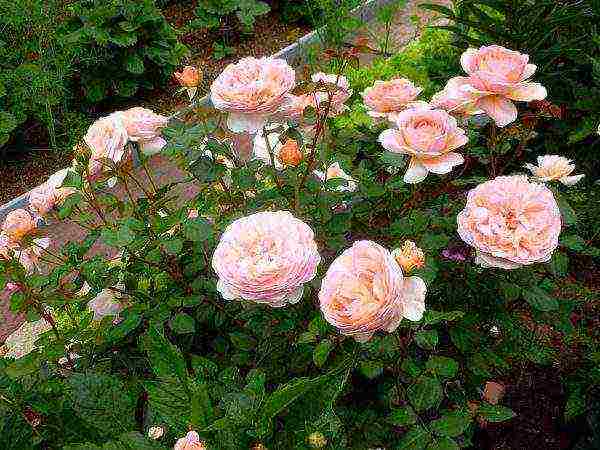
Ebrehem Derby variety
- a unique variety of double British roses with a large "glass" of flower. The petals are pinkish at the edges, the center of the bud is of the most delicate apricot shade. Tall bush, drooping stems;
- average disease resistance;
- poor resistance to temperature extremes;
- flowering is repeated;
- features: very pleasant fruity aroma.
The Pilgrim
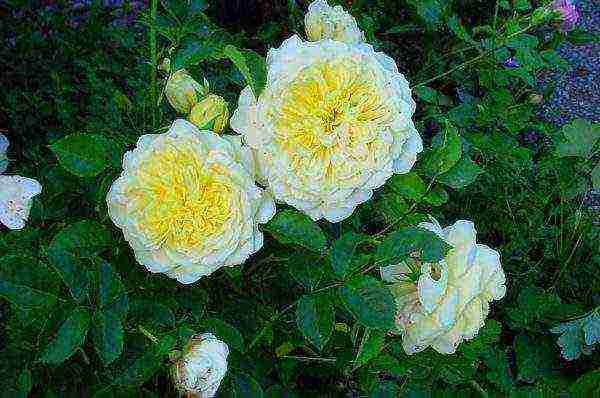
Ze Pilgrim variety
- Description: the buds of this beauty are yellow in dissolution, the petals are lighter at the edges. The bush is vigorous, the stems are tough. When grown on a support, the stems reach three meters;
- disease resistance: medium;
- resistance to precipitation: weak;
- re-flowering;
- blooms until October when properly pruned.
Tradescant
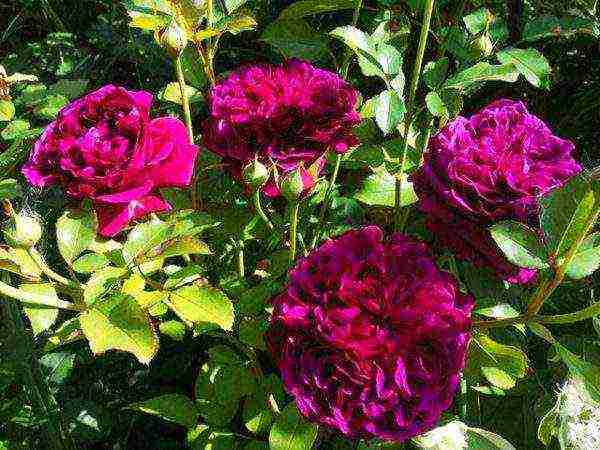
Variety Tradescant
- Description: medium-sized flowers of deep red or burgundy color. Leaves are dark, leathery, drooping stems. Tall, sprawling bush with tough stems;
- poor resistance to disease and precipitation;
- blooms again;
- features: pronounced aroma; responds well to the application of increased doses of fertilizers.
English Garden
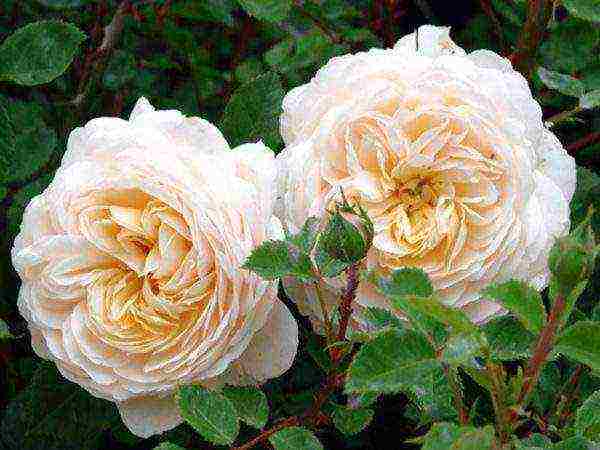
English Gardn variety
- magnificent flowers of unique shape and color: the center of the bud is yellowish, towards the edges the petals turn pale to white. Strongly branched bush, light foliage;
- disease resistance: satisfactory;
- resistance to rain and temperature extremes: weak;
- flowering: re-flowering;
- the plant is best planted in groups.
William Shakespeare

Variety William Shakespeare
- Description: Densely double, velvety, crimson-purple flowers in the form of a bowl, with a very pleasant aroma. Tall bush;
- disease resistance: medium;
- resistance to precipitation: medium;
- blooms again;
- a separate bud is kept in dissolution for two weeks.
Othello
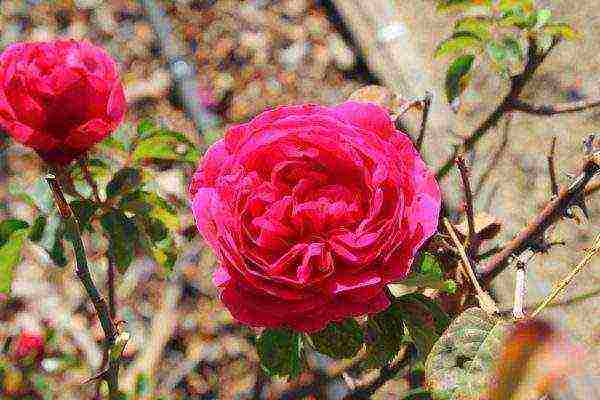
Othello variety
- crimson flowers, large bud. A pleasant aroma comes from the plant. It has a medium-sized shrub with hard thorns;
- good disease resistance;
- resistance to precipitation: medium;
- the possibility of re-flowering;
- features: the variety does not like hot climates.
David Austin roses look great in any garden. They can be grown as a small bush and used as a chic arch decoration.... The main thing is that they have taken root very well in Russian gardens, are unusually beautiful and are admired by any grower.
For the best varieties of David Austin roses, see the following video:
Rate the article:
(2 votes, average: 1.5 out of 5)
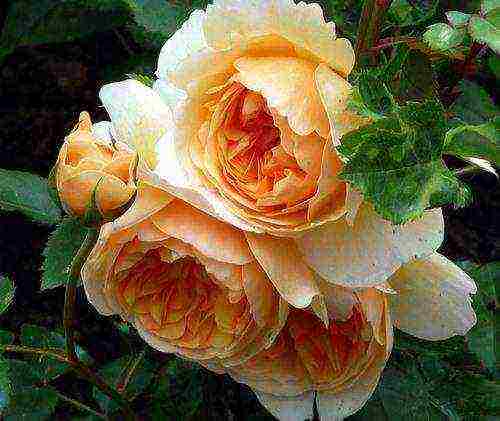 The magnificent and so different roses of David Austin, or David Austin roses, have become extremely popular not only in most countries of the world, but are also very much in demand in the home gardening of our country, which is due to a whole set of positive varietal characteristics. Many growers know this category under the name "English rose".
The magnificent and so different roses of David Austin, or David Austin roses, have become extremely popular not only in most countries of the world, but are also very much in demand in the home gardening of our country, which is due to a whole set of positive varietal characteristics. Many growers know this category under the name "English rose".
A bit of history
The English rose is a relatively new type of this decorative crop for cultivation in our country. This category of roses was the result of the selection work of a simple English farmer, David Austin, who, under the impression of ancient roses grown in France, was able to develop modern forms of decorative culture that resemble the most popular ancient varieties in appearance.
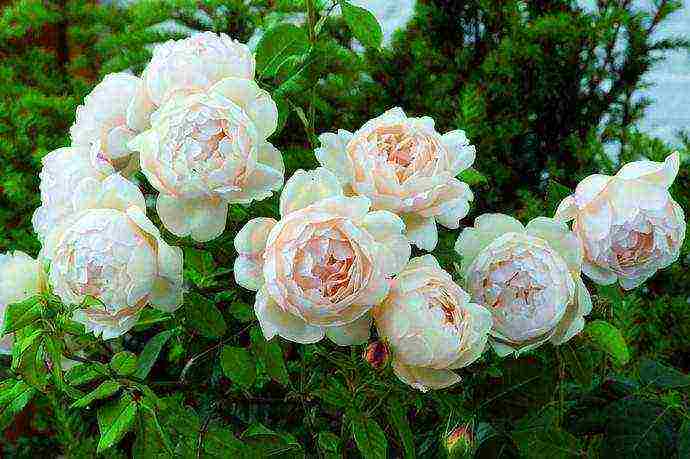
In the middle of the last century, David Austin crossed the ancient Gallic rose of the Belle Isis variety with the modern floribunda of the Dainty Maid or Le Grice variety. The result was a fairly tall rose bushes with very large and fragrant flowers. Thus, the Constance Spry shrub rose, well known to many amateur flower growers, appeared.
The hybridization carried out at further stages did not contribute to the improvement of the varietal characteristics of "Constance Spry", so David Austin decided to introduce this form into the scrub, which allowed us to open the pages of the history of the world famous English rose.
The best varieties of David Austin (video)
We recommend that you familiarize yourself with:
general characteristics
Compared to the well-known vintage roses, David Austin roses have a very pronounced aroma and proportional bush shape. Besides, the breeder managed to get varieties that have a yellow or orange shade of colors uncharacteristic for an old rose.
Long-term work in the direction of backcrossing with re-flowering roses made it possible to obtain seedlings with re-flowering, but negatively affected the resistance of plants to low temperatures and diseases. However, long and hard work in this direction has become the key to obtaining several very promising and popular varieties all over the world.... Currently, twelve varieties of David Austin roses carry the "quality seal" which was awarded by the English Royal Society of Floriculture Royal Horticultural Societty Award of Gardéen Merit, and for many amateur flower growers are justifiably a true standard of beauty and grace.
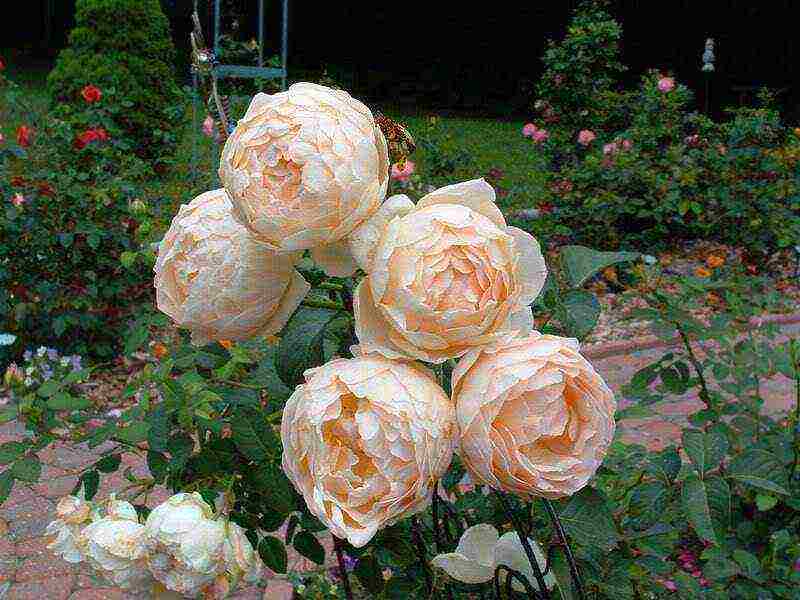
Promising and demanded varieties
The most popular and rightfully the best varieties of David Austin roses still never cease to amaze flower growers around the world. These winter-hardy and rather unpretentious ornamental plants in care are characterized by long and very attractive flowering, and also have a rich color and shape of flowers. The hallmark of all English roses is still the presence of a very strong aroma. The most pronounced and very pleasant aroma is in the popular and demanded variety "Jude The Obscure".
| Name | Description of the plant | Characteristics of flowers | Varietal features |
| "Juliet", or "Juliet" | Vigorous, well developed bush with sufficient foliage and dark green leaves | Creamy or peach-pink, with a very delicate aroma and dense buds | Widely used in mono bouquets and complex flower arrangements |
| William Shakespeare-2000 | A vigorous ornamental plant with strong and tough shoots | Raspberry-purple flowers up to 100 mm in diameter, with a violet scent | Possesses sufficient winter hardiness and resistance to the most common diseases |
| "Mary Rose" | Vigorous and very powerful bush up to 1m high | Bright pink, gradually fading flowers of an old classical form with an unexpressed aroma | Prolonged flowering, prone to black spotting |
| Al De Braithwaite, or L.D. Braithwaite " | An adult plant up to 1 m high, with a fairly slow growth rate and lush foliage | The brightest red flowers of all known varieties of English roses | Very decorative and well-branched bushes are formed. |
| "The Mayflower" | Vigorous, well developed bush with sufficient foliage and dark green leaves | Flowers of medium size, classic shape, with a pronounced aroma of Damask rose | A variety well adapted to the soil and climatic conditions of our country |
| "Wollerton Old Hall" | The growth of the bush is powerful and harmonious, stable at all stages of the growing season | Very large, well-formed flowers with rounded petals, creamy white color and flesh-colored center | A fragrant and disease-resistant variety, promising for home gardening |
| "Summer Song" | All flowers are collected in lush brushes and are concentrated in the upper part of rather powerful shoots | The flowers consist of smooth translucent tangerine-orange petals with a characteristic tea-fruit aroma | Even when using a very high-quality shelter for the winter period, the plant is able to lose more than half of last year's shoots. |
| "Abraham Darbi" | The foliage is dark green, with a characteristic glossy surface | Scrub with the formation of large, up to 140-160 mm in diameter, apricot-pink, double type, very fragrant flowers | Shoots often droop under the weight of too large flowers, so the plant needs support and a garter |
| "Pat Austin" | The plant is well developed, no more than 1 m high, with abundant decorative foliage | The flowers are relatively large, bright, copper-yellow with an orange tint. | Shoots often droop under the weight of large flowers, so the plant needs support and a garter |
| "Gentle Hermione" | Shrub up to 1.2 m high, vigorous, well developed, with sufficient foliage and dark green leaves | Pale pink, double-type, cupped flowers, with a delicate and pleasant, delicate aroma | A re-flowering variety with abundant, lush, long-lasting flowering |
| "Charlotte" | The foliage is dark green, with a characteristic glossy surface | Flowers of an unusually delicate and pleasant yellow color, attractive cupped shape | The variety has inherited the best qualities from old and modern varieties of roses. |
| Graham Thomas | The height of an adult, fully formed bush is no more than 1.5 m.The plant has a bushy, branched shape | The flower diameter is 100-120 mm. Flowers with a very clear and unique yellowish color | Abundant and very long flowering. The variety is characterized by an intoxicating aroma with hints of tea |
English spray roses in garden design
David Austin roses have a great aroma and special charm, and unlike many other types of ornamental culture, they are capable of year-round flowering. Practically all varieties of English roses are characterized by a spherical bush and many inflorescences, the color of which may vary depending on the varietal characteristics.
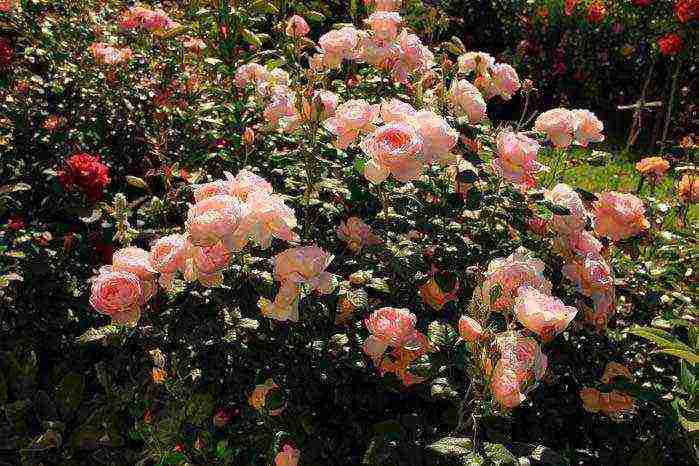
Currently, varieties with golden and bright yellow flowers are especially in demand in the conditions of home landscape design. Certain varieties of David Austin roses are great for decorating a flowering hedge. English miniature shrub roses are often the perfect addition to flower beds and flower beds. David Austin also developed varieties for use in container gardening using flowerpots or flower pots.
English roses: features (video)
In order to create the most decorative flowering borders, it is best to select two varieties of roses of the same height, alternating them when planting. Almost all varieties are favorably distinguished by repeated flowering, which allows you to get a very effective design of the garden plot.
In order not to lose the material, be sure to save it to your social network by clicking on the button below:
Attention, only TODAY!
Reviews and comments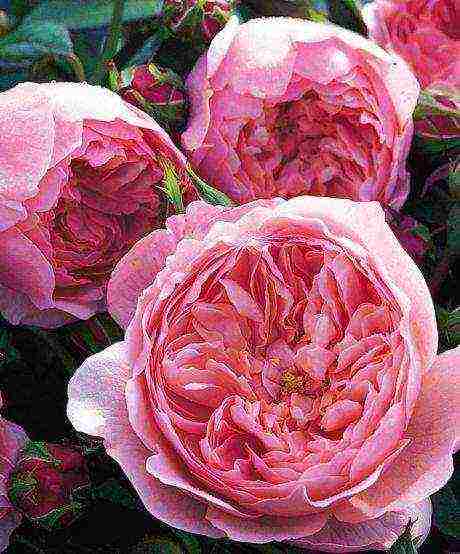 David Austin rose varieties
David Austin rose varieties
Alnwick Rose - very beautiful at all stages of flowering, the bud forms large. A dense, double, cup-shaped flower of intense pink color and more delicate pink on the outer edges of the petals, a raspberry-tinged scent.
0 0
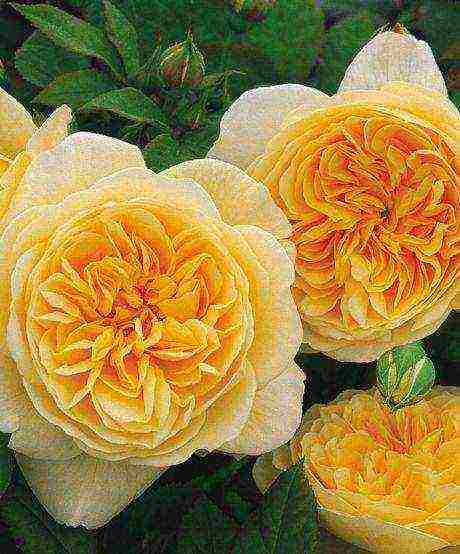 David Austin rose varieties
David Austin rose varieties
Teasing Georgia - withdrawn in 1998. Flowers are densely double, cup-shaped, vigorous bush, disease resistant, re-blooming.
0 0
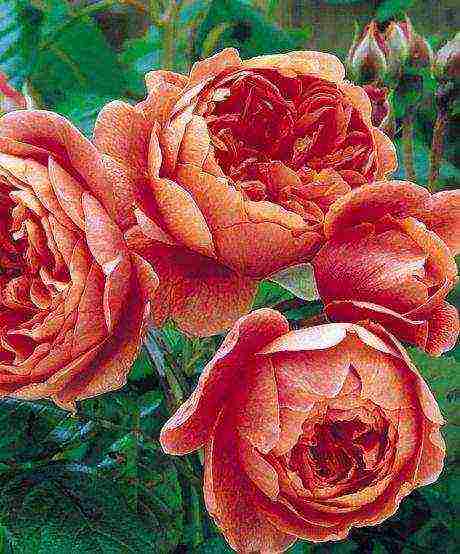 David Austin rose varieties
David Austin rose varieties
Summer Song is a fragrant rose with a completely unusual color of flowers that blooms profusely throughout the season, belongs to the exclusive varieties of D. Austin.
0 0
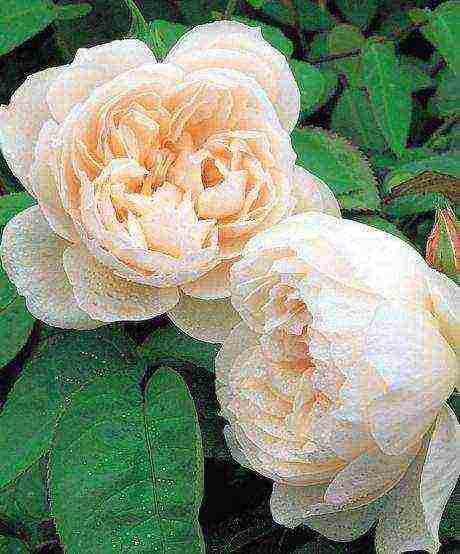 David Austin rose varieties
David Austin rose varieties
The Generous Gardener is a sophisticated rose with perfectly formed flowers. The petals are pale pink. When the bud is fully open, the flower resembles a lily. It forms a strong bush, has an exquisite aroma.
0 0
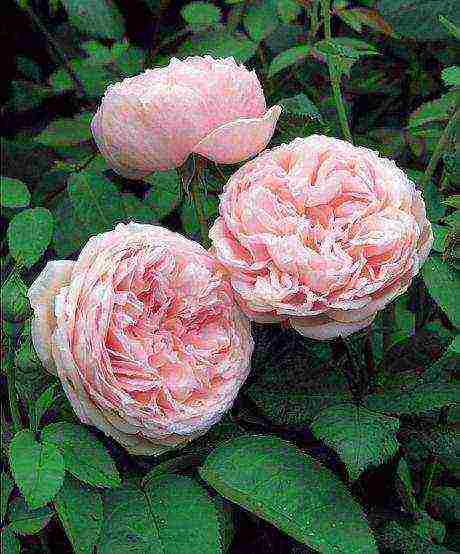 David Austin rose varieties
David Austin rose varieties
Spirit of Freedom - flowers are very large, delicate bright pink, turning into lilac-pink, tall, vigorous bush. The variety is resistant to diseases, re-blooming.
0 0
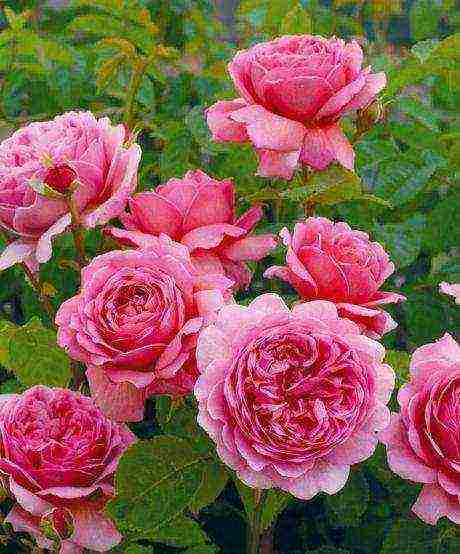 David Austin rose varieties
David Austin rose varieties
Princess Alexandra of Kent - flowers up to 15 cm in diameter with a delightfully fresh and unusually changing aroma during flowering: from tea through lemon to black currant aroma.
0 0
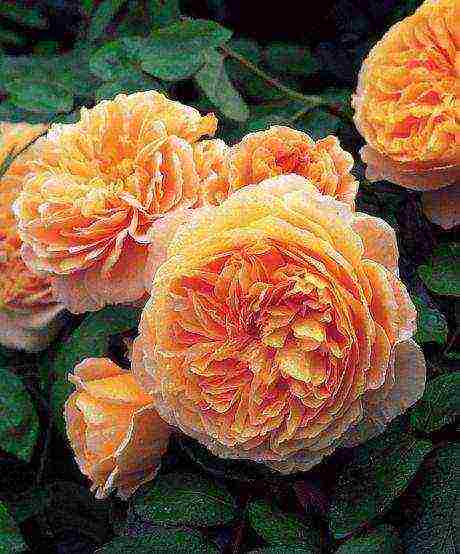 David Austin rose varieties
David Austin rose varieties
Crown Princess Margareta - flowers are large, beautiful apricot-orange color. The variety grows even in the harshest conditions. Has a strong fruity aroma. Bush up to 1.1 m.
0 0
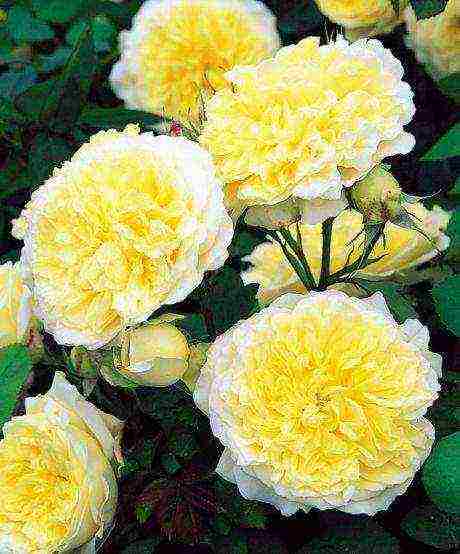 David Austin rose varieties
David Austin rose varieties
The Pilgrim is an unusually stable and healthy shrub with beautiful inflorescences, the flowers are bright yellow in the center and lighter towards the edges, large in shape, with a strong aroma.
0 0
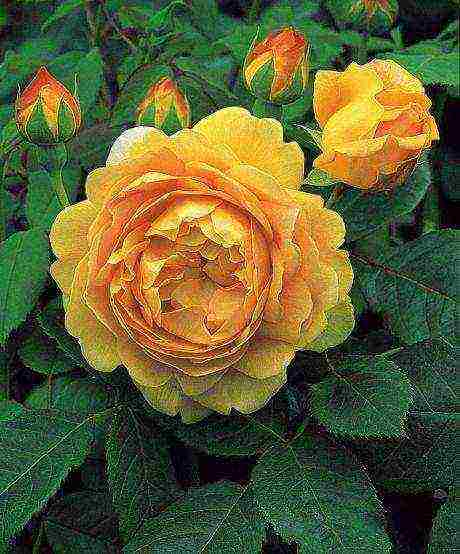 David Austin rose varieties
David Austin rose varieties
Golden Celebration - one of the best roses, rich yellow-gold flowers in the shape of a large cup. A beautifully shaped shrub, slightly arching with a lot of foliage. The variety is very aromatic. Bush up to 1.1 m.
0 0
 David Austin rose varieties
David Austin rose varieties
Claire Austin is disease resistant and has an extremely strong aroma. It begins to bloom in a pale yellow color, then changes to white-cream. Plants form into a bush about 1 m high and 0.9 m wide. This is one of the healthiest English roses.
0 0
 David Austin rose varieties
David Austin rose varieties
William Morris - flowers have a beautiful pink-apricot shade and an unusual rosette shape. It is an extremely hardy and reliable variety, ideal for backgrounds. Has a strong aroma and excellent re-bloom. Good disease resistance.
0 0
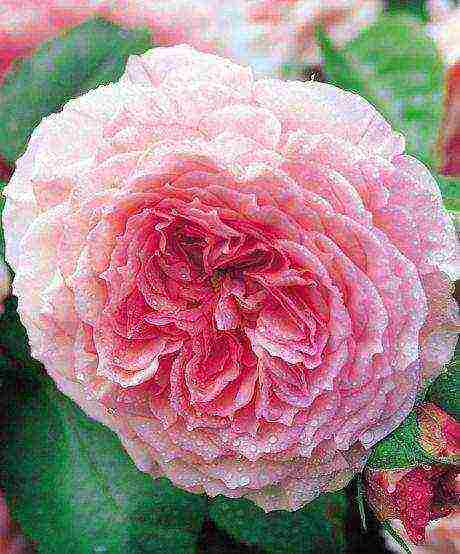 David Austin rose varieties
David Austin rose varieties
James Galway is a gorgeous, large shrub, good for planting in the background, and disease resistant. The flowers are large, double, in the center they have a rich pink tint, towards the edge the shade is paler.
0 0
 David Austin rose varieties
David Austin rose varieties
The Wedgwood Rose - the flowers of this variety are one of the most beautiful among all English roses. The variety is resistant to diseases. The flowers are medium or large, with the most delicate petals. The color is pale pink.
0 0
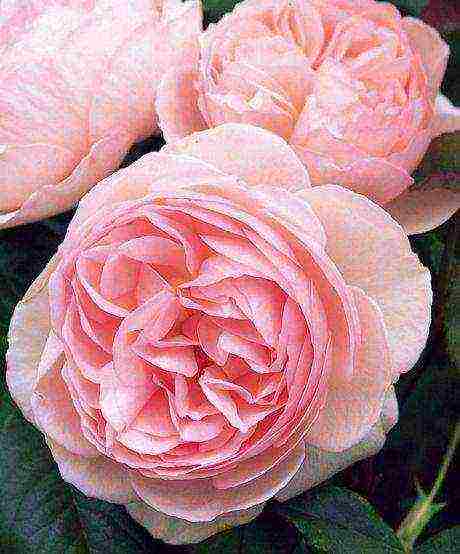 David Austin rose varieties
David Austin rose varieties
Heritage - has charming flowers of pure pink color in the center, the outer petals are almost white. Forms a beautifully shaped bush. Has a wonderful aroma with undertones of fruits, honey and cloves.
0 0
 David Austin rose varieties
David Austin rose varieties
A Sropshire Lad is a large-flowered fragrant peachy pink rose with a delicate fruity aroma in the tradition of tea roses, disease resistant, very effective when grown as a climbing rose.
0 0
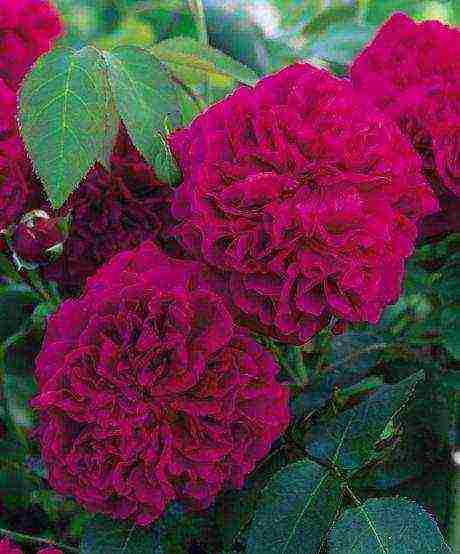 David Austin rose varieties
David Austin rose varieties
William Shakespeare 2000 - undoubtedly the best dark red English rose. The bush is tall, each stem has several inflorescences.
0 0


